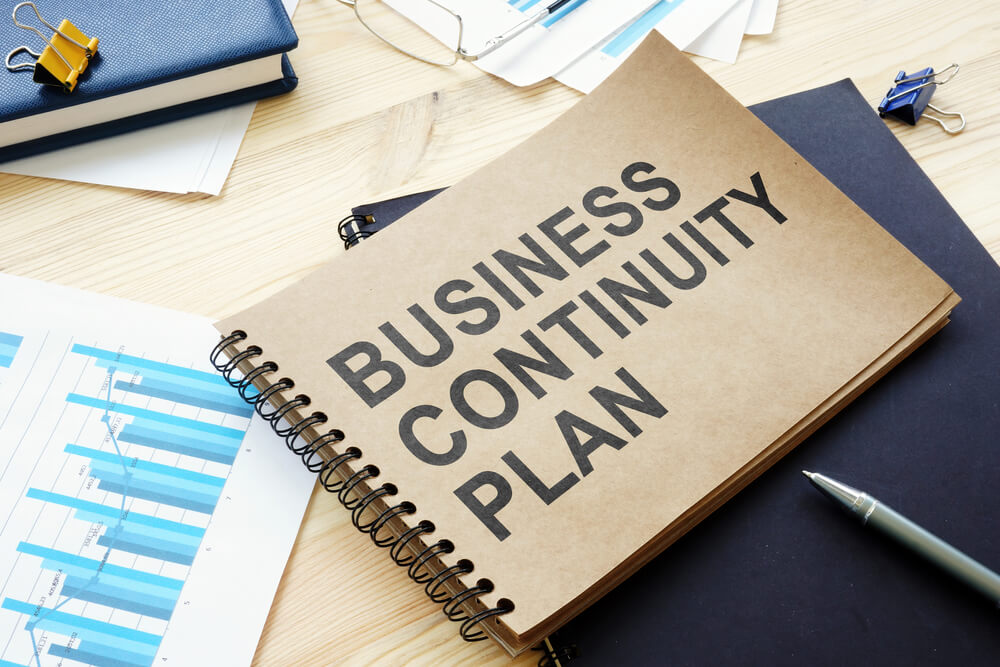Business continuity is the preparation and planning taken to ensure that a company can operate its normal functions during and after a crisis. Disruptions, such as losing a key employee, a supply chain failure, a cyberattack, and floods, can occur on your business premises. Failure to plan for these events can interrupt your organization’s daily activities, which may eventually lead to its closure.
Whether it’s a public sector organization, business, or charity organization, you need to know how to ensure that the company runs optimally under all circumstances. You can achieve this through business continuity planning, which entails developing a plan that will assist in averting operational interruptions when crises and disasters occur. In addition, this plan will also protect the company from such disruptions. If they occur, it will help return the business to normal.
The essential requirement of a business continuity plan is to keep regular business functions running during a crisis and restore the company’s normal state with as little downtime as possible. A business continuity plan must consider random events like fires, cyberattacks, natural disasters, and disease outbreaks for the project to work.
Any business can use a business continuity plan to enhance its production and prevent interruptions. This continuity of business plan might not be practical for small enterprises, but it can be much more effective for large organizations that want to keep all functions running during a disaster. However, for these business continuity plans to be effective, you must decide the operations that are crucial to your business and allocate the available budget accordingly. After identifying the essential components, supervisors can put failover mechanisms into action.
Using technology systems like disk mirroring allows businesses to record their data in geographically dispersed areas and the primary data center. This protects your company’s data against loss and allows you to access the data even when a crisis disables one location.
The Importance of a Business Continuity Plan
A business continuity (BC) plan is always essential when downtime is intolerable. Several sources can result in downtime, like extreme weather conditions and cyberattacks. Since you can never plan when these threats might occur, it’s crucial that you set up a business continuity plan that protects your business from such disruptions and allows the proper flow of business operations.
This plan should allow the organization to run at least at minimal levels during any predicament. Failure to implement a business continuity plan can cause an extended outage that might tarnish the company’s reputation and even create financial problems. With a properly placed BC plan, the company can retain its resilience in acting quickly to disruptions. This helps save the company’s reputation, time, and money.
A BC plan calls for a company to analyze itself, know its strength and weakness, and gather the information that might help the company during and after any crisis. Through this, a company can improve its resilience, technology, and communication sector, enhancing its production levels.
An effective business continuity plan can provide the company with a clearer and deeper understanding of the organization. Procedures involved in creating a business continuity plan and managing and maintaining it must include the stakeholders, suppliers, dependencies, and structures. Therefore, the information shared is not essential for BC management only but can also help strategize and plan in other organizational management and development areas.
Business continuity plans entail an exploration of the company’s culture. Practical strategies and plans will utilize change techniques, which will allow the employees to embrace everyday risks. This will give them individual responsibilities that enable them to mitigate, manage, and report threats.
What Does a Business Continuity Plan Entail?

Business continuity plan covers the preparation and planning needed to ensure that a company can perform its normal operations during and after a crisis. A great plan must have contact information, a guide on using the document, and steps to undertake when the company faces several accidents.
An ideal business continuity plan must have guiding principles that the organization should follow to retain its normal operations. During a crisis, no one should ask questions about keeping up with the business’s procedures. Remember, the employees, customers, and the company are all at stake during a risky situation.
Proper business continuity management must have several response levels. Since everything is mission-essential, you must identify the most vital business procedures that will remain running, even in a crisis. And after that, be honest about disaster recovery point objectives and recovery time objectives.
Even though IT might be the backbone of a continuity plan, it is crucial that you communicate essential information with the whole organization. You must include the entire organization, from senior to junior staff members, for the continuity plan to work. Another part that you must emphasize is working closely with the company’s security team. Although the IT group and security team work separately, a company can benefit greatly when it shares continuity plan information between these departments.
Main Components of a Business Continuity Plan
The most crucial components of a business continuity plan are contingency, recovery, and resilience. A company augments resilience by creating vital infrastructures and functions, considering that a disaster can occur. These include keeping a surplus of capacity, data redundancy, and staffing rotations. By ensuring resiliency against threats like harsh weather, a business can help maintain essential services off-site and on location without interruptions.
After a disaster, it is always crucial that an organization develop a fast recovery plan to restore the company’s daily functions. Designing disaster recovery time objectives for different networks, applications, or systems can help determine the elements you must recover first. Other recovery plans include using converted areas for critical functions and resource inventories.
A contingency plan includes several commands that allocate responsibilities within all departments in a crisis. These include duties like damage assessment, hardware replacement, and contacting third-party companies for help.
Disaster Recovery vs. Business Continuity
Disaster recovery planning is a subset of business continuity. It involves procedures being put in place to help a business after post-failure problems. These plans are primarily data-centered and concentrate more on how you can access data after a disaster. Business continuity planning accounts for all this, but it also focuses on managing the risks and keeping the business running during an interruption.
Business Continuity Development
For a business continuity plan to work, you must start with implementing the planned project. Risk assessment and business impact analysis are crucial steps that help acquire information for the plan.
Conducting a business impact analysis can help determine different departments’ possible weaknesses and impacts. Through this analysis, businesses can identify essential functions to prioritize in a continuity plan.
The best way to identify potential hazards that might affect a company is through a risk assessment. Risks can have a negative impact on the firm’s reputation, building operations, staff, and customers. Through risk assessment, you can identify the type of risks, who is at risk, and the impact level.
Managing a Business Continuity Plan
It’s crucial that you identify who should manage a business continuity plan. One person can manage the continuity plan of a small business, while a whole team of experienced professionals can handle a larger organization. You can also opt for management software — either cloud-based or on-premises — as it helps design and update plans, conduct business impact analysis, and identify risk areas.
Business continuity planning should be a never-ending process. Hence, the business continuity plan should never sit on the shelves. The team managing it should communicate the contents of the continuity and disaster recovery plan to many staff members as well. They should also collaborate with different departments within the organization to enhance the plan’s efficiency.
Testing the business continuity plan is crucial to its effectiveness. Thus, to succeed, the company should conduct training exercises for employees to know what to do in time of an actual crisis. You should also learn to test a continuity and disaster recovery plan to know its effectiveness. A test can be simple, like a tabletop exercise, where the employees discuss what can happen in case of a crisis. However, you can engage in rigorous testing for enhanced effectiveness, like an emergency mock-up, where the management plans a test without informing the employees.
After completing the test, the company can review how the test went down and update the continuity plan accordingly. However, the test should not stop at that point, especially if the company changes its staff and operations frequently.
Kick-Off With Something Manageable
At first glance, it might be challenging, but identifying the crucial applications and processes and executing various recovery plans and strategies are requirements for a practical and functional BC plan. For a plan to work, it must have an organizational structure for your team and necessary checklists and guidance for your management team, IT department, and business unit. This will allow quick action and response if a crisis hits your business.
And if the management team has issues executing ideas, having a strategy and plan in mind will offer much-needed structure if a crisis occurs. You should note that having a plan is essential since the structure will be much more important than perfection in an emergency.
The Business Continuity Management (BCM) Team

The continuity program must have a continuity management team for a large company. As mentioned earlier, for that plan to work, it requires a management team packed with experienced and trained professionals. The team’s core members must include sponsors, a manager, an assistant manager, and an administrative assistant. These individuals should be responsible for directing BCM efforts and implementing policies.
The sponsor should be the senior manager with overall accountability and responsibility for the continuity program. Below the sponsor, you will find the manager who will have direct responsibility for the business continuity plan. The assistant manager will serve as the backup plan manager and could be an assigned position or a titled position. The administrative assistant’s work will be to support the BCM team. The individual to fill this role will be an assistant working in the business continuity office, if there is one, or an employee from the administrative assistant team.
However, you must also involve representatives from the IT department and business units to offer input to create recovery strategies for technology and business functions. From an operational perspective, the non-BCM members will complete the duties of recovery preparation while the leading team will provide support and guidance.
The Business Continuity Plan Process
The initial step to an effective planning process is ensuring that you understand the crucial components and functions of the organization. You can conduct a threat and risk assessment and business impact analysis to guide you. Without knowing the risks and threats inherent to your company and how crucial the organization’s processes are, you cannot create effective strategies and plans.
The next step is to create a business recovery plan. This helps ensure that your organization can recover the business process in an emergency. Your business recovery plan will include the actions to be performed, including a short-term workaround, which will be compulsory to maintain the firm’s operations until the personnel, facilities, systems, and IT applications are available.
Having an IT recovery plan is another crucial step if you want to have an effective BC plan. Recovery planning is the development of strategies and plans that help recover your technology. These include creating actions that will help restore IT systems and applications. Lastly, you must have a crisis management plan. This is a plan that highlights how your company will manage and remain operational during a crisis.
For further help, we encourage you to visit our website. If you want to find out more about a business continuity plan, don’t hesitate to contact us at Frontier Business Products.

